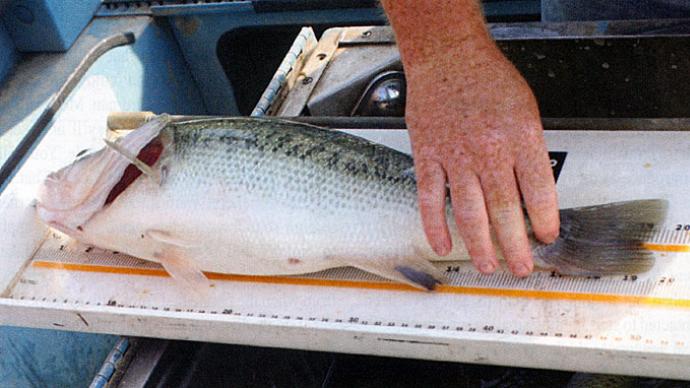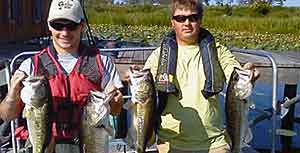
Often, a pondmeister will ring my number, send an email, or message me asking, "Should I tag my fish?" The standard answer is, "Probably not."
Tagging isn't something people do just for fun; it takes quite a commitment. But, if someone wants to track individual growth, monitor activity and recruitment of an entire population, or maybe study catchability of individual fish, tagging can be a good idea.
For many of us, studying fish is a passion and a way of life. When we get the chance to do something outside our normal box, we'll often seize that opportunity. It gets even more exciting when we get to be involved in cutting edge research that most certainly will impact the future of fisheries biology, like the radio tagging project going on near Athens, Texas.
You've likely heard about radio tagging. Rarely is this done in the private sector, primarily because most people just don't have the time or the resources to do it properly. After all, who's got time to sit in a boat two or three days a week and follow fish around to see where they go? Besides, what's the point? Toss in the fact that radio tags are custom-built, cost about $200 a pop, and must be surgically implanted, and that's a formula that makes most people shy away—and maybe choose to read about it, instead.
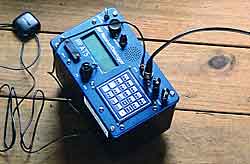
Well, that's not the case at Eagles Nest Preserve, east of Athens, Texas. 125 acre Grand Lake is the focal point of this 600+ acre property. Family owned, this ranch is dedicated to improving habitat for fish and wildlife. Part of that focus is structured, meaningful research to improve the resource and then share that knowledge with the entire industry. For the fishery in Grand Lake, with largemouth bass as the target, a research project has been ongoing for 18 months. It started with a cooperative agreement with South Dakota State University's Natural Resources Department, led by department head Dr. David Willis, and fisheries professor Dr. Brian Graeb.
Initially, 85 adult largemouth bass were electrofished from the lake and sacrificed. Each fish was weighed and measured and otoliths were removed to determine age structure for the lake. Fins were clipped to collect DNA to identify the genetic composition of these fish. Then, 660 adult Florida strain largemouth bass were stocked during the next two months, each one PIT tagged for identification, weighed, measured, and released. DNA from fin clips was taken from these fish as well.
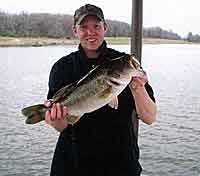
The mission for this exercise? To see if the newly introduced Florida bass will grow well and influence the gene pool of the entire lake—and if so, to what extent. Next, Ph.D. student Jason Breeggeman, from SDSU, traveled to the ranch several times in 2012 to collect 40-50 bass, pump their stomachs, collect the contents, and haul said stomach contents back to the lab to do a detailed study of what the fish eat seasonally. He'll use a bioenergetics model to draw conclusions about seasonal food habits of bass in this lake.
Now, it's time to track movement of fish for the next 18 months. Radio tags were designed and built for this project and over Memorial Day weekend were surgically implanted into 15 bass.
The goal is to implant a total of 40 fish with tags and then study their movement around this lake compared to several variables. There's a receiver that scans over the water and can pick up a "ping" for each tag. When a ping is heard, it can be identified to that particular tag's number and based on the frequency of the ping, Breeggeman can determine the temperature of the water, calculate the depth where the fish is, and the GPS location of that fish at that moment. Those data points are collected and put on a map.

Breeggeman and Tyler Trimpe, his assistant, will be on the lake each week, maybe as much as two to three days, to monitor movement of each fish they can find. From this study, they'll be able to determine a variety of things about behavioral habits of largemouth bass. They'll see how water temperature affects bass movements. They'll be able to monitor the food chain as its season ebbs and flows and how that food chain influences fish movement. There are a variety of end gain results of this research.
But, for this article, let's learn about the process of putting a radio tag inside a fish. Part of the methodology was to capture fish two different ways, electrofishing and angling. Of the first batch of 15, seven were caught on hook and line, eight were taken by electrofishing. The biggest of the batch was just shy of eight pounds.
When a fish was caught, it was immediately hustled to the dock for surgery. It was anesthetized in a 48 quart cooler with 60 parts per million (ppm) clove oil in the water. After less than five minutes, the fish was calm. Next, it was placed on the operating table, specially designed for this project by Breeggeman. The fish was placed on its back and a two inch incision was made just behind its pelvic fins, on the left side of its abdomen. Dr. Graeb made most of the incisions, careful to cut through only the flesh and not get into the gut cavity of the fish. Once the incision was wide enough, the sterilized tag was pushed into the gut cavity of the fish and the incision was quickly sutured. Most fish wound up with four stitches, for those of us who like to know such things. As the surgery was being done, another student manned a small pump. The surgical table sat in a tub of water. This water had a half-dose of the anesthetic and the small pump had two hoses that pumped a low volume of water. The student manning the pump flushed water over the gills of the fish as the surgery was done. Surgery lasted less than five minutes on each fish.
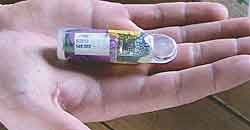
Once stitched up, the fish was placed in a 250 gallon tank of aerated lake water that was continually being pumped through the tank. Once revived, and recovered from the anesthetic, the fish was immediately rushed back to the place where it was captured and gently released.
The whole process, from capture to release, took less than 30 minutes per fish.
It was a fun exercise to watch, plus the excitement of everyone involved was apparent. They know this project is likely to have an impact on the way biologists manage small waters across the nation.
Given all the elements of this research, it is easy to see how likely it is this project will impact the pond management industry. It will influence how we use fish to enhance genetics of existing fish populations, how we choose to manage a food chain, and will give us an idea how fish use underwater habitat, structure, and cover in their day to day lives as they adjust to water conditions and the food chain.
Valuable research, wouldn't you say?
Reprinted with permission from Pond Boss Magazine

